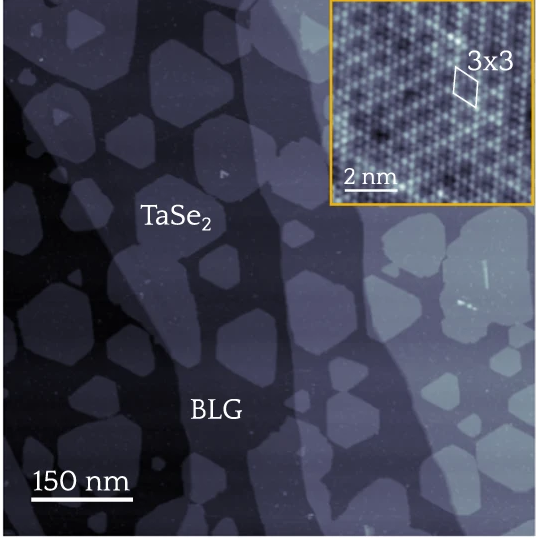Emergence of superconductivity in a metallic single-layer by minute electron doping
The isolation and manipulation of atomically-thin crystals have recently enabled the investigation of a wealth of exotic electronic phenomena. A remarkable example is the case of superconductivity in transition metal dichalcogenide monolayers, where the strong spin-orbit coupling, together with the lack of inversion symmetry, triggers the emergence of unconventional superconducting properties.
In parallel to the exploration of the intrinsic ground state in correlated 2D systems, there has recently been an increasing interest in tuning their many-body electronic states. A successful approach here is the use of ionic gating. An alternative method to tune the electronic properties of a layered material is by chemical substitution. However, this approach has rarely been used to manipulate many-body states. Interestingly, chemical-doping strategies enable to interrogate the robustness and fundamental properties of many-body states in the presence of disorder, which remain largely unexplored due to the lack of suitable platforms.

Thus, the chemical approach is a promising route for the exploration of a rich variety of doping- and/or disorder-dependent collective phenomena in low-dimensional quantum materials. Now, a team of researchers shows 1 that transition metal dichalcogenide alloys are ideal platforms for this approach. In particular, the researchers demonstrate the emergence of superconductivity in an otherwise metallic single-layer by minute electron doping provided by substitutional atoms.
The researchers first demonstrate that a monolayer of TaSe2 does not hold superconductivity down to 340 mK (using samples unexposed to air) by using variable-temperature (0.34–4.2 K) scanning tunnelling spectroscopy. Then, they proceed to embed W atoms in the TaSe2 lattice that will be acting as electron donors. This is confirmed by resolved scanning tunnelling spectroscopy measurements.
They subsequently probe the low-energy electronic structure of lightly doped TaSe2 monolayers and unveil the emergence of a superconducting dome on the temperature-doping phase diagram. Optimized superconductivity develops for a W concentration of 1.8% with TC ~ 0.9 K, a significant increase from that of bulk ( TC = 0.14 K).
The superconductivity dome reflects the variations in the available electrons for pairing, as the layer is electron doped. Superconductivity emerges from an increase of the density of states as the Fermi surface approaches a van Hove singularity due to doping. Once the singularity is reached, however, the density of states decreases with electron doping, which gradually weakens the superconducting state, thus shaping the superconducting dome.
The absence of superconductivity in a nearly isolated high-quality monolayer of TaSe2, on one hand, changes the picture of dimensionality effects on superconductivity in transition metal dichalcogenide alloys and calls for further theoretical efforts and, on the other, makes further experimental investigation in this type of alloys in search for signatures of topological superconductivity worth the effort.
Author: César Tomé López is a science writer and the editor of Mapping Ignorance
Disclaimer: Parts of this article may have been copied verbatim or almost verbatim from the referenced research paper/s.
References
- Wan, W., Harsh, R., Dreher, P., de Juan, F. & Ugeda, M.M. (2023) Superconducting dome by tuning through a van Hove singularity in a two-dimensional metal. npj 2D Mater Appl doi: 10.1038/s41699-023-00401-4 ↩